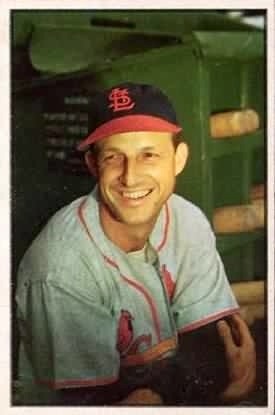Historical Hitter October 11th 1948: Stan Musial

If your team is from Beantown and wears red stockings, October 11 is your day; for better or worse. In the era before baseball playoffs this day was a day of joy, however, with the expanded post-season, the 11th is the day to avoid. In the playoffs it’s a day of angst as the team is winless: ’86, ‘02, ‘07 &’ 08. In the World Series the results are opposite: six times played on this day, and six victories: ’12 (3-1 over the Giants); ’15 (2-1 vanquishing of the Phillies); ’16 (6-2 victory over the Dodgers); ’46 (6-3 beating the Cardinals); ’67 (8-4 beating the Cardinals again) and ’75 (6-0 whitewashing of the Reds).
Yesterday the batter of the day, St. Louis Brown’s (Cardinals) Tip O’Neill had the best hitting season of the 19th Century. Only one player has come close to matching that season’s performance; Stan Musial in the magical 1948 season where he lead in every major hitting category except for home runs. Stan the Man hit 39 – he was just one short of Ralph Kiner’s league leading 40. The best hitting seasons of the 19th and 20th Century baseball belong to St. Louis Cardinals players O’Neill and Musial.
It is more than appropriate to have St. Louis’s and Baseball’s best hitters back to back.
 The other batting similarity O’Neill and Musial share is in the World Series. While the 19th century versions were considered exhibitions, the winner was still the Champion club for the season. Both men played in four post-season series and for the only times in their baseball career were average: Musial hit a normal .256; O’Neill a meager .240.
The other batting similarity O’Neill and Musial share is in the World Series. While the 19th century versions were considered exhibitions, the winner was still the Champion club for the season. Both men played in four post-season series and for the only times in their baseball career were average: Musial hit a normal .256; O’Neill a meager .240.
They also share something bigger than being just a ballplayer. Both men have awards honoring their legacy, sportsmanship, and their grace in being positive role models. In Canada it’s the Tip O’Neill award, and from St. Louis it’s the Musial Awards ™.
While considered a natural from the day he first picked up a bat, Musial was dedicated to his craft. He was known to spend hours in the batting cage practicing his perfect swing. With a lifetime in baseball Branch Rickey observed that the veteran needs batting practice as much as the rookie. Rickey knew that to stay in the game one needed to adjust to stay in the game. The ideal veteran practice for Rickey was to:
“…practice stepping back with his rear foot instead of advancing with his front foot to hit to the opposite field. He loses power but remains just as dangerous.”
Did Rickey write this in his book, as an homage to Musial? Perhaps. What is certain is Musial’s dedication and work ethic.
“Unless you give it all you’ve got, there isn’t any sense in playing,”
Musial’s work effort and determination to succeed were noted by teammate Kurt Flood who said:
“If this immortal felt the need for frequent extra practice, how could I hope to prosper on less effort?”
As Jan Finkle, in Musial’s SABR Bio Project essay, confirms Musial’s work habits and the example he set for his younger teammates.
“The picture that emerges–one not often seen by the public–is of a Musial with raw, bleeding hands, the result of time spent in the batting cage honing his “natural” abilities”
 Musial’s perfect swing was his own trademark. It was unique to him and while not to be copied, as Musial’s Hall of Fame page notes:
Musial’s perfect swing was his own trademark. It was unique to him and while not to be copied, as Musial’s Hall of Fame page notes:
Stan Musial hit the ball the wrong way.
Corkscrew stance. Off-balance follow-through. Inside-out swing.
But Stan Musial played baseball the right way.
Stan the Man lived life the right way too, as his St. Louis statue is engraved with the phrase:
“Here stands baseball’s perfect warrior,
Here stands baseball’s the perfect knight”
[divider]
Sources:
Musial Awards: http://stlsports.org/awards/features/celebrate-the-legacy/
SABR BioProject by Jan Finkel: http://sabr.org/bioproj/person/2142e2e5
Baseball-reference.com
Baseball-almanac.com
